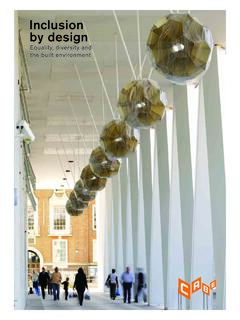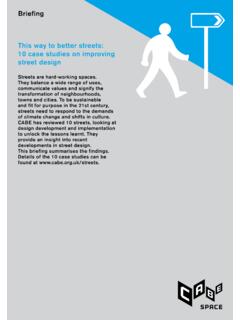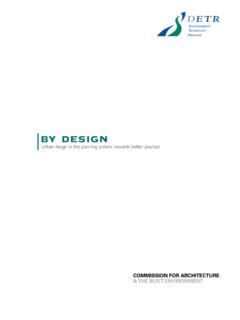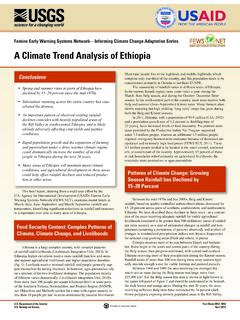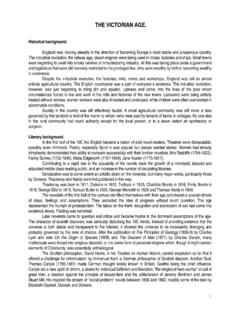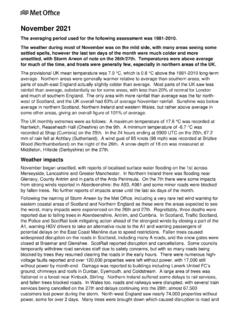Transcription of Community green: using local spaces to tackle inequality ...
1 Community green: using local spaces to tackle inequality and improve health 1. Contents 1 Introduction 3. 2 Literature and project review 9. 3 The household survey 18. 4 Key findings and conclusion 40. Bibliography 45. Appendices 49. 2. 1 Introduction Community green uniquely investigates The report demonstrates that improving urban the inter-relationship between urban green green space represents an important and cost- space, inequality , ethnicity, health and effective opportunity for people to transform their local neighbourhoods and improve their quality of wellbeing. It is the largest study of its kind life. local people are best placed to know the in benefits that good-quality green spaces contribute to their Community .
2 But they have not always had Some of the most acute effects of the opportunity to direct improvements to their deprivation are felt by black and minority local environment. ethnic communities living on a low income in urban areas. The poor quality of their A changed political and economic landscape will include a fundamentally different relationship local environment has a considerable between local people and landowners, including impact on their health and wellbeing. registered social housing providers and local authorities. The most obvious opportunity is People living in deprived urban areas improving the open space on social housing estates. recognise and appreciate the value of Chapter 4 sets out the findings from the study.
3 local green spaces , but they underuse the Background to the study spaces that are most convenient because these spaces are often poor quality and Sustained investment in recent years arrested feel unsafe. The study found, for instance, the historic decline of public urban green spaces , that less than 1 per cent of people living in especially parks. People are using their parks social housing reported using the green and green spaces more, and value them more. space on their estate. Almost nine out of 10 people use parks and green spaces and value this use for their health and But even during this period of relative prosperity, not everywhere benefited equally.
4 This study follows earlier research commissioned by CABE, Urban green nation: building the evidence base, Cultural diversity enriches and vitalises which explored over 70 major data sources to discover collective life, and is desirable not only what the quantitative data says about England's publicly owned and managed urban green space. It found that if for minority communities but also for you live in a deprived inner-city area you have access to the society as a whole. It adds a valuable five times fewer public parks and good-quality general aesthetic dimension to society, widens green space than people in more affluent the range of moral sympathy and imagination, and encourages critical self- In this second piece of research, Community reflection When the public realm prizes green: using local spaces to tackle inequality and uniformity, diversity tends to be devalued improve health, we focused on ethnicity because diversity is increasing.
5 It is no longer accurate to throughout society' 5 talk about ethnic minorities' in some areas. In the Professor Bhikhu Parekh last decade there has been a large increase in the percentage of black and minority ethnic young people. For instance, half of the Bangladeshi 1 R esearch by OPEN space research centre, Edinburgh College of Art, in collaboration with Heriot-Watt University. population in Britain is under the age of 2 U rban green nation: building the evidence base CABE, 2010. 3. Health, ethnicity and inequality Providing good-quality green space is a hugely effective way to tackle these inequalities. Green Urban green nation also revealed that in areas where space has been proven to reduce the impact of more than 40 per cent of residents are black or deprivation, deliver better health and wellbeing minority ethnic there is 11 times less green space than and create a strong Community .
6 The simple in areas where residents are largely white. And the presence of green space is related to a reduced spaces they do have are likely to be of a poorer quality. risk of serious problems like depression and lung disease. Living close to green space reduces Although where you live and the services you receive mortality, which can help reduce the significant is intimately related to income, our research found gap in life expectancy between rich and a difference, by ethnicity, that was over and above what would be expected for level of income alone. The Liverpool city green infrastructure strategy The majority of the UK's black and minority ethnic identifies areas of the city where climate change communities live in the most deprived wards in may have a particular impact.
7 It highlights a English inner-cities. The poverty rate for Britain's relationship between high levels of coronary black and minority ethnic residents overall is heart disease and poor mental health and low 40 per cent, double the rate for white British quantities of green space in parts of the city. people. Furthermore, child poverty is highest, up The strategy's action plan sets out 37 actions to 74 per cent among Bangladeshi to ensure that green infrastructure is built into proposals to deliver health and wellbeing The relationship between low income and poor benefits and help address potential issues that, health follows a social People living if not addressed, will arise in the long on a low income are more likely to experience worse health and be less physically active.
8 The 2010 Marmot Review of health inequalities revealed that the gap in life expectancy between the rich and poor is greater in England than in three quarters of the Organisation for Economic Co- operation and Development (OECD) In addition, some groups report worse health. Bangladeshi and Pakistani people and African-Caribbean women, for instance, are more likely to report bad or very bad health compared to the general This inequality matters. Some people must manage a greater number of burdens yet have fewer economic and environmental assets or resources to draw upon. Historically, poor areas in towns and cities have 6 Ethnicity and family: relationships within and between ethnic groups, Platts, been exposed to a larger share of environmental risks and dangers.
9 In a changing climate they are also most likely to suffer disproportionately. inequalities in England post-2010, 2010. For a list of the OECD countries For example, they are more likely to flood and 10 E ffect of exposure to natural environment on health inequalities: an to experience the urban heat island effect. observational population study, Mitchell, R and Popham, F, The Lancet: 372, 2008. 11 T he Liverpool city green infrastructure strategy, Mersey Forest Commissioned Planning for the future must take this into account by Liverpool City Council on behalf of Liverpool First for Health and and ensure some areas are not more likely to be Well Being, 2010.
10 Hazardous to health and wellbeing than others. 4. The study methodology This study used a range of qualitative and quantitative research methods: There is little research investigating income and race inequalities in relation to urban green space literature review of over 100 publications A. provision and use. While a lot is already known and articles on urban green space, deprivation about the relationships between income and and ethnicity and its contribution to health ethnicity, and income and health, there have been and wellbeing. A review of 50 projects very few studies that look at how green space, engaging people in the design, ownership ethnicity or deprivation, and health are related.



